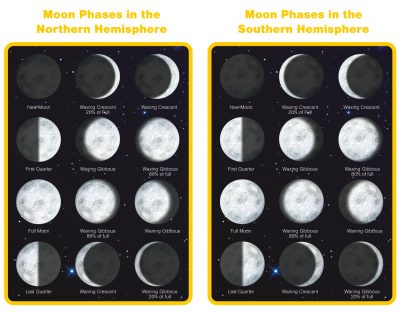Moon Phases
From Earth, we see the Moon appear to change shape throughout the month, from a crescent to a Full Moon and back again. What we are seeing is part of the Moon illuminated by the Sun, depending on the position of the Earth, Moon and Sun in the sky. This is called a phase of the Moon.
The Moon orbits the Earth near to the Equator, so people in different hemispheres see the moon from a different vantage point. People in the Northern Hemisphere are standing on the opposite side of the globe to the people in the Southern Hemisphere, so in effect we are upside down to each other! So, a person from one hemisphere will think the Moon looks upside down if they go to the other hemisphere. Likewise, the way we view the Moon phases is different in each hemisphere, as shown on the charts above.
When the Moon is between the Earth and the Sun the side of the Moon facing us is dark and this is called a New Moon. After the New Moon the Moon is said to be waxing, or gaining in strength or brightness. When the Moon is on the opposite side of the Earth to the Sun, the side of the Moon that we see is fully lit up and this is a Full Moon. After the Full Moon the Moon is said to be waning, or decreasing in strength or brightness. The time that the Moon takes to complete its full cycle from New Moon to New Moon is about 29.5 days or a lunar month.

